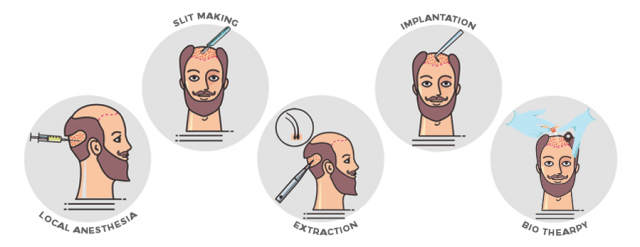There are hair transplants and then there are methods that work just like a transplant, but there is an extra step that is added to it, which makes the procedure a lot more effective. For instance, Bio FUE is a normal FUE transplant for all practical purposes, but when a biotherapy is added, the results are not only better but also faster. The procedure is not one that concentrates on the immediate future but is actually a long-term plan, designed uniquely for each patient, based on their extent of hair loss. Each person is different – their hair texture will differ and their hair loss will also be different, which is why Bio FUE therapy has to be customized for each person.
The Bio FUE procedure is done in 5 main steps:
- Local anaesthesia – Local anaesthesia is administered so as to ensure that the patient does not have to bear any pain or discomfort throughout the procedure. However, in most places, the method of administering anaesthesia itself is extremely painful. The most painless method of administering anaesthesia is by applying a numbing gel to the base of the scalp first and allowing it to take effect, which normally takes about 20 to 30 minutes. Once the gel has taken effect, the injections for anaesthesia will not pain at all. The clinics that offer Bio FUE will also use extremely thin needles, which will reduce the pain of the injections all the more.
- Slit making – In most FUE procedures, the grafts will be removed and then stored in a solution, until the time to implant them comes. Once the grafts have been extracted, the surgeon will make slits to implant the grafts and many a times, because the slits are of various sizes, the growth is uneven. However, in the hands of an experienced Bio FUE surgeon, you and your grafts are safe. Experienced surgeons will make the slits before the extraction, because in this way the time spent by the grafts, outside the body is minimal. Initially, a few test grafts will be taken out and the length of these grafts will be checked. A specially designed blade, which can be cut according to the size of the hair graft will then be sized as per the average size of the graft and this will allow the surgeon to make very precise slits. In the hands of a good surgeon, you can be assured that the grafts will be placed at the proper angle, and the direction, as well as the density of the hair, will be maintained, in accordance with the real hair.
- Extraction – Extraction is almost always done from the back of the head, because that is generally the donor area. In FUE, the grafts are extracted by making sharp punches, which go deep into the scalp, loosening the graft completely. However, it is imperative that the extraction is done only from the permanent zone, because any grafts removed from the areas that are not permanent will fall out. With the help of methods such as flat punch, surgeons can ensure that there is a minimal amount of wastage during the extraction process. It is also important that consecutive grafts are not extracted, because when side by side grafts are removed, there is nothing left to cover the blank space. Experienced surgeons will ensure that consecutive grafts are not removed and there are no blank spots left, post extraction. Such precise extraction will also ensure that there is minimal wastage.
- Implantation – This is perhaps the most important step of a transplant process – in most clinics, grafts will be extracted, they will be stored in a solution till the time the implantation site is prepared and once the slits have been created, the grafts will be implanted. For the implantation process, the grafts are often help on a gauze, which often leads to the dehydration of the grafts, making them useless. However, at the best of clinics, the implantation will be done simultaneously with the extraction, reducing the out of body time for the grafts to the minimal. In addition, such clinics will make sure that the first grafts to be extracted are also the first to be implanted. Ideally, the graft should be held by the tip and not the root, because this reduces the chances of damage and the grafts should be kept moist at all times.
- Bio therapy – Now comes the part that makes Bio FUE hair transplant different as opposed to a regular FUE transplant. PRP or platelet rich plasma therapy is a procedure that is gaining quite a reputation for enhancing hair growth and when the procedure is done in tandem with a hair transplant, not only are the results better, but the healing is also faster. For PRP, a small amount of blood is extracted from the body and placed in a centrifuge. The plasma is separated and treated with growth factors, after which, the now truly potent serum is injected back into the scalp. Once back into the body, the PRP will stimulate the stem cells which are present in the scalp and ensure better growth and faster healing. Studies have shown that when bio therapy is combined with a hair transplant, the texture of the hair is a lot better and the transplant results are much more improved.
If you are considering a hair transplant, considering a Bio FUE might be the best option for you.
















































































